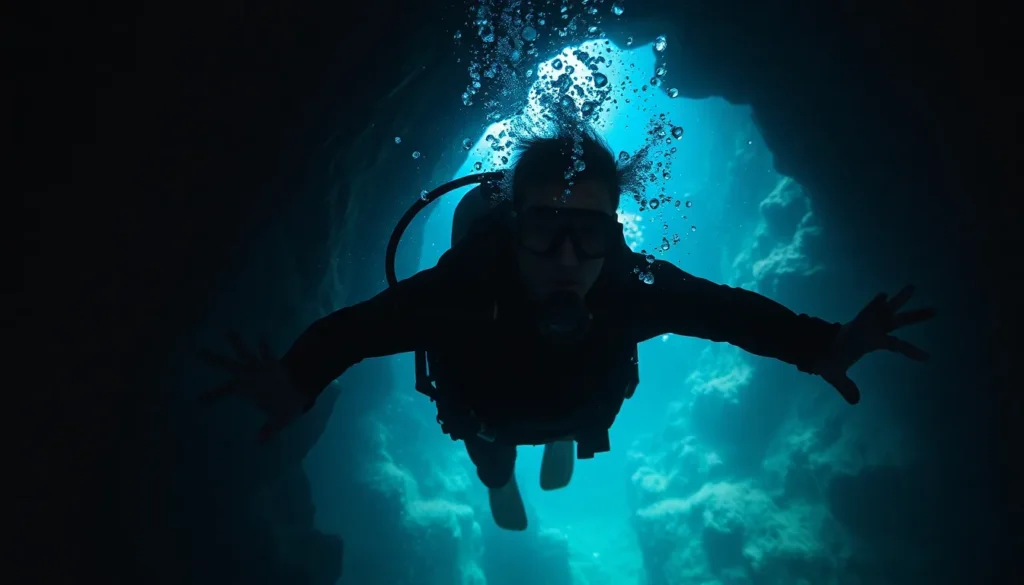Table of Contents
ToggleDiving into the mysterious depths of Anglehozary Cave might sound like an adventure straight out of an action movie, but it’s not all fun and games. Beneath the surface lies a world filled with unexpected dangers that could turn a thrilling experience into a hair-raising nightmare. From treacherous currents to low visibility, this underwater labyrinth is not for the faint of heart—or those who forgot their floaties.
Overview of Anglehozary Cave Diving
Anglehozary Cave presents a complex underwater environment that attracts experienced divers. Treacherous currents pose significant risks, often sweeping divers off course. Low visibility can further complicate navigation, causing disorientation and increasing the potential for accidents. Emerging from sudden turns or shallow depths may yield unexpected encounters with limestone formations or submerged debris.
Depths within the cave can exceed 100 feet in certain sections, intensifying pressure-related issues. Temperature variations create discomfort, sometimes leading to hypothermia if divers are unprepared. Problems with equipment, such as gear malfunctions, may arise, emphasizing the necessity for meticulous pre-dive checks.
Divers must account for the unique geography of the cave, which includes narrow passages and varying chamber sizes. Exit routes can be uncertain, especially for those unfamiliar with the layout. Unstable underwater terrain may lead to sand movement, further obscuring pathways.
Comprehensive training and familiarity with cave diving techniques remain crucial. Knowledge of gas management, emergency procedures, and communication methods enhances safety. Failing to adhere to these practices can result in dire consequences.
Diving in Anglehozary requires not only skill but also a deep respect for its dangers. Heeding the warnings and preparing adequately sets the stage for a safer exploration of this captivating underwater world. Each dive must be approached with caution and a clear understanding of the inherent risks involved.
Dangers Associated with Anglehozary Cave Diving

Exploring Anglehozary Cave presents inherent risks that divers must acknowledge. Awareness of these dangers can significantly enhance safety during dives.
Unpredictable Water Conditions
Strong currents can occur suddenly within the cave. These swift water movements may disorient divers, pushing them off course and complicating navigation. Visibility often diminishes due to sediment disturbance, which exacerbates the challenges faced in such an environment. Divers can find themselves in dark areas where even experienced divers struggle to orient themselves. Awareness of these unpredictable conditions is vital for diver safety.
Risk of Getting Lost
Narrow passages and intricate chamber layouts present significant navigation issues. Divers unfamiliar with the cave’s geography often lose their sense of direction, increasing anxiety and potential danger. Identifying exit routes becomes especially challenging when visibility is low or when diver experience is limited. Pre-dive briefings that emphasize thorough memorization of the layout can aid in preventing divers from getting lost. Signaling devices may also provide a means of communication during emergencies.
Equipment Failure Risks
Reliable gear is crucial for cave diving, but failures can occur unexpectedly. Breathing apparatus malfunctions can quickly become life-threatening, underscoring the importance of regular maintenance and thorough pre-dive checks. A diver’s ability to respond calmly to equipment failures directly influences survival chances. Carrying backup equipment, such as extra tanks and regulators, offers a safety net in case of primary gear failure. Comprehensive training on managing equipment issues can further reduce risks associated with diving in Anglehozary Cave.
Health Hazards in Cave Diving
Cave diving presents various health hazards that pose significant risks to divers. Awareness of these dangers is crucial for ensuring safety during underwater exploration.
Decompression Sickness
Decompression sickness, often called “the bends,” can occur when a diver ascends too quickly after reaching depths greater than 100 feet. Nitrogen gases accumulate in the body under pressure and must be released gradually during ascent. Symptoms can include joint pain, dizziness, and in severe cases, paralysis or death. Recognizing the signs ensures prompt intervention, making thorough training on safe ascent techniques essential. Planning dive profiles with adequate decompression stops significantly reduces the risk of this potentially life-threatening condition.
Hypoxia and Other Medical Emergencies
Hypoxia results from insufficient oxygen supply, especially when divers exceed their limits or mismanage gas mixtures. Symptoms such as confusion, shortness of breath, and unconsciousness may occur rapidly. Implementing proper gas management practices is vital to avoid these dangerous situations. Other medical emergencies, like equipment malfunctions, can exacerbate risks and necessitate reliance on backup gear. Regular training to handle scenarios like entrapment or equipment failure equips divers with the skills needed to navigate crises effectively.
Safety Measures for Cave Divers
Safety measures significantly enhance the chances of a successful dive in Anglehozary Cave. Divers must focus on proper training and the use of suitable equipment.
Training and Certification
Training is essential for any cave diver exploring Anglehozary Cave. Divers should obtain certifications from recognized organizations, such as the National Association for Cave Diving. Courses must include rigorous instruction in cave diving techniques, emergency procedures, and gas management. Differentials in cave environments, navigation skills, and communication protocols are critical components of this training. Experience is equally important; divers should undertake numerous dives in varying conditions to build familiarity with diverse underwater terrains. Ongoing education keeps skills sharp and knowledge current, especially regarding new technologies and techniques.
Use of Proper Equipment
Proper equipment plays a vital role in ensuring safety while diving in caves. High-quality gear, including wetsuits, buoyancy control devices, and diving regulators, must meet industry standards. Regular maintenance of equipment is crucial; oversight can lead to equipment failure under pressure. Divers should always carry backup gear, such as an additional air supply and underwater lights. These contingencies provide an extra layer of safety during unexpected situations. Personal flotation devices are also essential, given the unpredictability of waters in Anglehozary Cave. Divers need to familiarize themselves with new equipment prior to dives, ensuring confidence in operating it during critical moments. Properly functioning equipment and familiarity reduce risks associated with cave diving significantly.
Anglehozary Cave diving is a thrilling yet hazardous endeavor. The risks associated with this underwater labyrinth demand respect and careful preparation. Divers must be acutely aware of the potential dangers including strong currents low visibility and pressure-related issues.
Proper training and reliable equipment play crucial roles in ensuring safety. It’s vital to remain vigilant and prepared for unexpected challenges that may arise during the dive. Each exploration should be approached with a clear understanding of the environment and the inherent risks involved. With adequate preparation and respect for the cave’s dangers divers can enhance their chances of a successful and safe adventure in this captivating underwater world.






